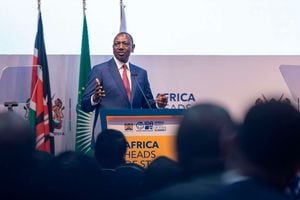There is need to safeguard the African middle class

Shoppers at the Nakumatt supermarket branch in Busia. PHOTO | TOM OTIENO | NATION MEDIA GROUP
What you need to know:
- There is need for countries to invest in bigger industries in a variety of sectors.
- Effort must be made towards value addition, manufacturing and diversifying economies.
In May 2016, Henning Melber, a political science professor from Pretoria University wrote a paper titled "Africa’s rising middle class: time to sort out fact from fiction". He analysed the capacity of the African middle class; essentially driving the last nail into the Africa Rising narrative advanced by The Economist five years earlier in 2011.
Long before Melber’s paper, questions had been raised on the definition and classification of the middle class in Africa, India and China. Compared to the developed nations, the middle class groups in these countries seemed rather poor.
The World Bank puts the middle class household’s daily income or expenditure at between $2 (Sh207) to $10 (Sh1,038) per day. This works out to an average income of Sh6,000 to Sh30,000 a month.
500 MILLION
On the other hand, the African Development Bank defines middle class as anyone who spends between $2 (Sh207) and $20 (Sh2,077) a day. The bank declared that the continent has more than 500 million people in the middle class.
Kenya National Bureau of Statistics defines the middle class as those spending Sh23,670 to Sh199,000 on a monthly basis.
This definition is a bone of contention in itself. How do you define someone making $60 (Sh6,231) a month as middle class?
NOT ISOLATED
The definition debacle is not isolated to Africa. According Mckinsey Consulting group, the Chinese middle class is 54 per cent of its urban population, translating to about 405 million people. India boasts of a middle class of 600 million. A Mumbai University study indicates that the Indian middle class includes carpenters, street vendors, decorators and drivers among others. The same is true in Africa.
A construction worker at the standard gauge railway earns a minimum of Sh25,000 per month, equivalent to what a graduate earns as a salesman in a bank.
Kenya produces over 50,000 graduates annually. Unfortunately, only about half of these can be absorbed in graduate entry jobs. The biggest employers are banks, telecommunication companies and the government. The other half is forced to wait forever, start businesses without capital or settle for blue collar jobs like carpentry and hawking.
FAMILY BURDEN
The lucky half that have jobs have the unfortunate duty of carrying the family burden. They take care of their aging parents and educate their siblings. In essence to have any savings, they are forced to lead lives similar to their counterparts in carpentry.
Yet in spite of these difficulties, the Kenyan middle class is spending. The Oxford Business Group says that the average value of consumer spending in Kenya has risen by as much as 67 per cent in the last five years, making Kenya the fastest growing retail market in Africa. Our spending on mobile phone airtime has delivered super profits to Safaricom. A visit to a slum house in Kibera can reveal 42-inch plasma TVs and stereo systems.
GROUP EDGY
On the flipside, the World Bank cautions that the African middle class and its counterparts in Asia have the characteristic of being edgy and highly susceptible to economic shocks. Given the difficulty in securing a job, a retrenchment in Kenya is almost equivalent to a retirement. Further, during election seasons like now, most construction workers remain jobless as developers adopt a wait-and-see attitude.
Additionally, the region is sensitive to international shocks like recessions and policy change. The terror attacks in the country killed tourism at the coast for a while. A ban on miraa has left thousands of Meru residents without income.
To safeguard the African middle class, there is need for countries to invest in bigger industries in a variety of sectors. Effort must be made towards value addition, manufacturing and diversifying economies.
Odhiambo Ramogi is the chief executive officer of Elim Capital.
@Odhiamboramogi




